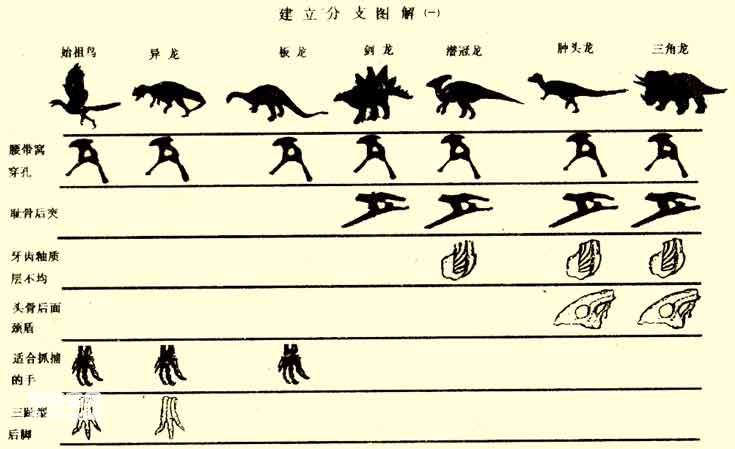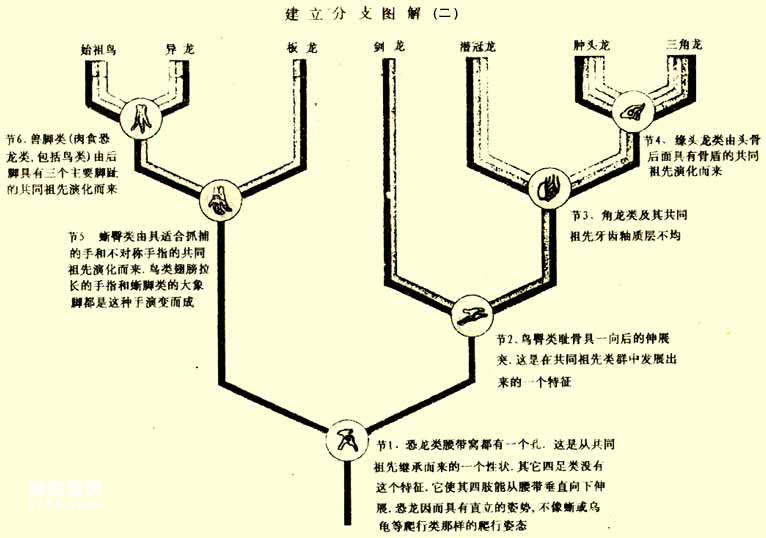In June 1995, the American Museum of Natural History reopened its two dinosaur exhibition halls to the public after three years of renovation. The brand-new exhibitions immediately attracted great attention from the society. The new display not only makes the postures of dinosaurs more vivid and realistic, but also reflects the latest results of research on a large number of dinosaurs and their systematic relationships. The two-part exhibition of early dinosaurs and late dinosaurs arranged in chronological order in the past was replaced by the sauropod exhibition hall and the ornithischian dinosaur exhibition hall organized using the research results of cladistic systematics, allowing the audience to understand the family tree of dinosaurs. This is the first large-scale dinosaur exhibition in the museum world based on cladistics, the best modern scientific method for establishing biological affinities.

Dinosaur cladogram (1)
Cladistics, also known as phylogenetic systematics, is a method of determining the genetic relationships of various organisms. In the 1950s, the German entomologist Hennig first proposed the idea of cladistics. In the late 1960s, the American Museum of Natural History, under the leadership of Dr. Nelson, became a center for the further development and practice of this new scientific method. Since then, cladistics has gradually occupied a dominant position in the field of biological evolutionary relationships, and has had a profound impact on the efforts of paleontologists around the world to study a series of difficult problems ranging from the origin of birds to the geographical distribution of animals. The American Museum of Natural History places its dinosaur exhibit within the context of cladistics, which is representative of the research conducted by the museum's scientists.

Dinosaur cladogram (2)
The difference between cladistics and traditional methods of reconstructing biological system relationships is that it uses the characteristic distribution of commonly descended traits to test systematic relationships. Scientists mainly look for similar patterns of traits expressed in different animals. This distribution of traits usually combines several closely related groups to form a group hierarchy, with smaller groups included in larger groups. For example, the group "dinosaurs" is included in the larger group "vertebrates" because dinosaurs and all other vertebrates have backbones. The backbone is said to be a common descendant of the group of so-called vertebrates. Each group or clade is defined by a set of such closely related traits inherited from a common ancestor.
Although cladistics is not a perfect method so far and needs to be criticized and tested, it is a more reliable and objective method to determine kinship than using the age of fossils or the specific rock layers from which they originated. For example, cladistic analysis suggests that birds descended from a small carnivorous dinosaur likely like Deinonychus or Velociraptor. These carnivorous dinosaurs, emuosaurs, lived in the Cretaceous period from 107 million to 72 million years ago. However, the earliest bird now recognized, Archaeopteryx, lived in the late Jurassic period about 140 million years ago. If only based on geological time, scientists may come to a conclusion that is inconsistent with objective facts, that is, the earliest birds evolved into dinosaurs like Deinonychus and Velociraptor. So how to resolve this contradictory situation? The explanation of cladistics is that the fossil record may be incomplete, and there may be an older animal that is very similar to Deinonychus that evolved into birds and later emuosaurs including Deinonychus and Velociraptor. There are two branches of this class, but the fossils of this ancient ancestor animal have not yet been discovered.
By using combinations of traits to perform cladistic analysis, scientists can examine phylogenetic relationships or lineage trees, not to indicate who is the ancestor and who is the descendant, but only to assume that animals are most closely related to each other. When reliable phylogenetic relationship results cannot be obtained using the geological age of fossils, cladistic analysis can provide an important background of possible positional relationships in animal phylogeny. With cladistics, scientists have a more realistic and objective understanding of where evolutionary branches exist in geological time and where there are "missing links" in the fossil record among these evolutionary branches.
In the new dinosaur exhibit at the American Museum of Natural History, scientists selected the most representative genera of various dinosaur types to create a branching system diagram. When analyzing, the choice of shape is very important. For living animals, traits can be selected from various perspectives such as genetics, biochemistry and even behavior, but for fossils, they can only be limited to traits on bone structure. Therefore, paleontologists tend to be more restricted in their trait selection. Many traits are meaningless if they are too limited in distribution. For example, "deck" occurs only in Stegosaurus, one of the representatives of the cladogram in this example, so this trait does not provide any clues about the kinship of these specific dinosaurs in this example. The trait "limbs" exists in all dinosaurs and many other animals. This trait is too general and has little meaning. Using relatively restricted distributions to select traits often greatly reduces the number of potentially useful shapes.
For simplicity and ease of understanding, this cladogram here only shows 6 traits. In actual scientific research, scientists often use 20 to 100 traits to explore the genetic relationships between organisms.
By carefully comparing bones and charting the distribution of traits, it is possible to identify patterns of traits that repeatedly form the same group. Large amounts of data must be processed by computer programs. In every study, every discrepancy in trait distribution requires researchers to re-examine the specimens and examine issues such as whether the specimens are well preserved and whether the traits are truly the same or appear to be different. Then, the kinship system is visually depicted in a cladogram. The cladogram supported by the largest number of rows was selected as the best cladogram, but only as a basis for further research and not as a final, unchangeable conclusion. Science is endless. The introduction of new theories often causes many old theories to be eliminated. At the same time, some hypotheses that were not taken seriously in the past will be re-adopted. However, all these processes must be tested by science and practice. Even the cladogram on display in the American Museum of Natural History may only be the best cladogram for the time being.
In cladistic analysis, those characters that identify larger groups are called primitive characters because they are thought to have appeared earlier, while characters common to smaller groups are called progressive characters or derived characters because they appear later. In this approach, the concepts of primitive and progressive are relative and do not mean that some features are more advanced than others. In this example cladogram, "belly fossa perforation" defines the group "Dinophora" that includes all dinosaurs and birds. Among all vertebrates, the trait of "belt fossa perforation" is unique to dinosaurs, so it can be said to be an improvement compared to other vertebrates. But when studying subgroups within the dinosaur family, this trait is treated as primitive. Similarly, the four dinosaur genera that make up the group Ornithischia in the example are defined by a derived shape of the "retropubic process" that extends posteriorly from the pubic bone, and this trait is relatively primitive within Ornithischia because it appeared very early. characteristics.
Now, many scientists' interest in dinosaurs has shifted toward the study of their, in many cases, unique lifestyles and habits, rather than building on intractable evidence. Although the conclusions of cladistics are often changed due to the continuous discovery of new fossils, it is in this process that scientists have an increasingly detailed understanding of the biological relationships. Therefore, the cladistics method can be said to be an objective and good method to examine the path of biological evolution. The dinosaur fossils on display at the American Museum of Natural History are the most colorful in the world, and the collection layout guided by cladistic systematics allows the audience to gain more objective knowledge from the fossils themselves.
animal tags:
We created this article in conjunction with AI technology, then made sure it was fact-checked and edited by a Animals Top editor.